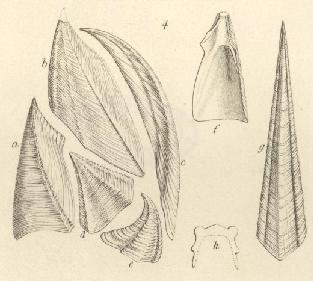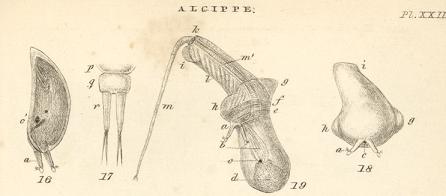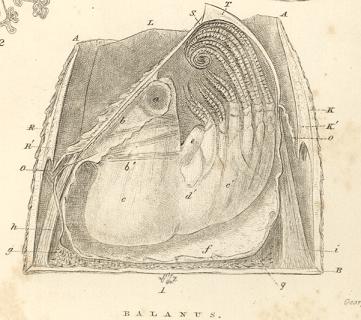
Darwin was to spend eight hard years on barnacles, toiling away dissecting these tiny creatures under the microscope. The result was a 4 volume monograph on the Cirrepedia, living and extinct – the authoritative text on barnacles then and probably still now. The barnacle years pushed him to his limits, his health almost bottomed out, he lost his father and mentor and then, crushingly, his favourite child Annie.
Why Barnacles?
On January 1835, on a beach in the Chonos Archipelago, off the coast of Chile, Darwin picked up a conch shell interested in some unusual boreholes drilled into its surface. So began Darwin’s study of barnacles. Back on board the Beagle he focused his microscope on the inhabitant of one of the holes. He was convinced it looked like a barnacle, but all his books told him all barnacles built themselves a house; this one was different. Intrigued, he decided to return to it later.
He did just that, but not for 11 years. In 1846, settled into a new house in Downe, Kent, and with a growing family, the barnacles were back in his thoughts. They had reason to be. Marine invertebrates were the darlings of British science in the mid 1800s; scientists were convinced they held secrets of life. Most of the great Victorian naturalists were busying away on some marine creature. The barnacles were one of the most mysterious and least studied groups. Until recently they had been classed as molluscs, but in 1832 William Vaughan Thompson had shown that the shelled, sessile adults developed from free swimming larvae; they were in fact Crustaceans (like crabs and lobsters). The young would swim around then, reaching adulthood, seek out a sturdy surface to spend the rest of its days. It would glue its head down to the rock, secrete a hard shell, and stick its feet out into the water sifting out even smaller creatures for food. But not much else was known about them.
In an article called The Present State of Zoology Darwin’s old friend Leonard Jenyns had put out a scientific call to arms, a thorough study of barnacles would yield important new discoveries and was overdue. Darwin was well primed for this call. In Edinburgh, mentored by Robert Grant he had begun his career working on sponges and on the Beagle voyage over half of his Zoology notebooks were devoted to marine invertebrates.
Barnacles offered Darwin an opportunity; if he could solve their mysteries and bring order to their messy classification he could make a large contribution to Zoology and cement his reputation as a leading naturalist. Besides, he already had a rare and intriguing collection of odd barnacles. How hard could it be? He reasoned he could wrap things up with the Cirrepedes in a year or so. One year was a bit optimistic, it would take eight.
Why Did He Spend So Long On Barnacles?
The naked, houseless barnacle Darwin had collected from the Chilean conch shell was nicknamed ‘Mr. Anthrobalanus’ (jointed-barnacle). In time Darwin would re-christen it with the full scientific name Cryptophialus. Mr. Anthrobalanus was an oddity; it didn’t fit the Barnacle mould. Darwin felt such an oddity would reveal the secrets to barnacle history – their evolutionary past. But to work out why and how Mr. Anthrobalanus was different and what these differences meant he would have to study every barnacle he could get his hands on. The challenge was made even greater by the shoddy efforts of those who had dabbled in barnacle classification before him. Barnacle classification was, he wrote, ‘perfect chaos… literally not one species is properly defined… the subject is heart breaking’.
He began setting himself up in Down House as the hub of a scientific network. Confined to his house by ill-health, he used his charm and reputation to twist the arms of barnacle enthusiasts and collectors into helping him out. He managed to get the great British museums to send their collections to him (a rare privilege, usually you would have to go to them), he wrote to contacts and contacts of contacts across the globe – to experts in Europe, collectors in America and as far round the world to his old servant Syms Covington, now encamped in Australia.
Soon enough boxes full of precious little creatures would arrive daily, the cargo containing both living species and fossil collections. Each one would have to be dissected, described in minute detail and compared to all the rest to search for affinities, similarities and variation. By the end of his eight-year ordeal, there was hardly a species which Darwin had not seen, dissected and described.

It was taxing work, hours spent bent over a microscope in a room full of the vapours of preserving spirits. Great care was needed too; he was taking apart other’s hard earned collections. Often samples would arrive in the post which had been crushed – to save face with their owners, and to make use of them Darwin would have to glue together the tiny crushed shells, like a miniature 3D jigsaw puzzle.
The work would have taken anybody years. But Darwin was not a well man. He suffered from palpitations, prolonged and violent vomiting, boils and embarrassing flatulence. No doctor he had seen could diagnose it with any confidence; ‘suppressed gout’ was the best guess of many (though what they thought that meant isn’t clear). His health was so bad he even installed a small toilet in his study behind a curtain for him to vomit into. In the end he was driven to try a fashionable new treatment; Dr. Gully’s water treatment. For this he would have to travel to Malvern where he would spend months wrapped in freezing cold wet towels, hours sitting beside a hot lamp sweating in streams and all day with a wet girdle round his belly.

Whatever this routine was supposed to do it did seem to help. After several months in Malvern in Dr. Gully’s health spa Darwin’s health was improving. He was impressed, and even had continued the treatment back at home. But part of Dr. Gully’s advice was to restrict work and stress to a minimum; when in Malvern all work was banned – he lost months at a time during relapses when he had to return to the health spas for treatment. Even at home he was only allowed to work a few hours a day; ever worried about her husband’s health Emma ensured the doctor’s orders were carried out with rigorous strictness.
So barnacle work was limited to a couple of hours in the morning, dragging out the epic study even more. Progress was slow, and at times the work seemed endless; ‘my cirripedal task is an eternal one; I make no perceptible progress… & I groan under my task’. At other moments his frustration is clear; ‘confound & exterminate the whole tribe… I can see no end to my work’.
With his health fluctuating and no end in sight to the barnacle work, he at times feared he would die before getting a chance to complete his great work on species. Death was certainly on his mind in these years. In 1848 he lost his father who had seemed indestructible to him in his youth, and in 1851 his eldest daughter and favourite child Annie died after a prolonged illness.
What Did He Discover?
For all his hard work, Darwin did achieve a lot from his study of barnacles. For a start he was the first person to classify a group of organisms according to the principle of ‘common descent’, the idea that related animals and plants all descend from a common ancestor. This was a central idea in Darwin’s theory of evolution and probably the only proposal to come from The Origin which was more or less immediately and widely adopted by the scientific community. He proved that barnacles were crustaceans, and made some masterly deductions on how the free-swimming larvae metamorphosed into sessile adults.

He also uncovered some fascinating aspects to the lives of barnacles. For example, before he began his work, it was thought that all barnacles were hermaphrodites, that is, they had both male and female reproductive organs. Not long into his work Darwin realised this wasn’t the case. In 1848 he was dissecting a species of barnacle called Ibla cumingii and was startled to find that they were all female. This was against the books! What is more, the females were covered by little black specks, he had seen these before but assumed they were parasites, this time he decided to take a closer look. Amazingly they turned out to be the Ibla males! These ‘complimental males’ were reduced to mere tubes filled with sperm living parasitically on the females. He checked a related species Ibla quadrivalus, some of its females were hermaphrodites but they still had these little males attached. Darwin saw this as a progression, from a hermaphrodite ancestor the sexes had become specialised in Ibla; I. cumingii and I. quadrivalus captured this process at different stages. These small, neglected creatures provided Darwin with glimmers of proof that his theory was right.
When, in 1853, he returned to Mr. Anthrobalanus, who had set him off on the barnacle trail, there was little Darwin did not know about the genus. But still Mr. Anthrobalanus was unique. Unlike all other barnacles which went through free-swimming larval stages, Mr. Anthrobalanus’s young never developed swimming feet. Instead the larvae crawled around with their antennae. The differences between the larvae Anthrobalanus and members of the genus Alcippe, which Darwin had thought was a close relative, were so vast that he was forced to create a new order for Anthrobalanus all of its own; Abdominalis. Despite the larval differences, the adult forms of Anthrobalanus and Alcippe were almost identical. Nature had stumbled upon the same solution to ecological problems twice independently, more evidence for natural selection.
Mr. Anthrobalanus had one more surprise in store; the biggest penis of any creature:
‘The probosciformed penis is wonderfully developed… when fully extended it must equal between eight and nine times the entire length of the animal!’
What Good Did It Do Him?

The Barnacle monograph was undoubtedly a profitable piece of work for Darwin, despite it eating up more time than he had bargained for.
The result of his work, a 4-volume definitive account of barnacles cemented his place in science. Despite its dry tone and specialist nature it received rave reviews in the scientific press. He was rewarded with many accolades, memberships to yet more societies and even the Royal Medal, one of the highest awards in British science.
He had increased his profile among professional scientists. He was a master of classification, taxonomy, comparative anatomy, and had authority to wade into the debate on species. Because of who he was and the standard of work he had done, his were the views of a great scientist; they were to be taken seriously, not dismissed as speculative.
As well as learning necessary new skills and gaining him a reputation for rigorous study in a wide range of fields, his barnacle studies also helped him refine his theory of evolution by natural selection. Prior to his barnacle work, Darwin had not realised how variable individuals of the same species were. Most people saw them as so similar they fit to ‘types’, and that whatever little variation there was mere meaningless noise. Darwin could now see differently:
‘I have been struck… with the variability of every part in some slight degree of every species: when the same organ is rigorously compared in many individuals I always find some slight variability’
This was an important realisation, one that no doubt aided the development of his species work and probably contributed greatly to a new line of work: variation in domestic animals. He was also forced to consider other points which would later reappear in The Origin; the similarity in appearance between Alcippe and Anthrobalanus and vestigial organs, the remnants of previously useful organs that had slowly fallen into disuse - all of these topics would need to be addressed in order to convince the sceptical reader that evolution is true. He had also gotten practice writing persuasive arguments, explaining his ideas by presenting evidence and the logic of his conclusions in bits, and building the reader up towards the final picture. This would come in handy for the species book.
Since he began the monograph, evolution was gradually coming under the focus of science, being debated on the basis of evidence. There was no acceptable mechanism for evolution still, and hardly any hard evidence. The scientific community was still largely against the idea of species changing.
Darwin was working on the mechanism required to explain evolution, and had gone a long way to collecting the evidence. But there was still work to be done; his theory of natural selection was not yet finished. Now, with friends and contacts all over the world, thanks to his barnacle network, he would begin bringing more evidence together.
Written by Stephen Montgomery
References & Further Reading
Darwin
by John van Wyhe, Andre Deutsch: 2009
Darwin
by Adrian Desmond & James Moore, Penguin: 1991
Darwin and the Barnacle
by Rebecca Stott, Faber and Faber: 2003